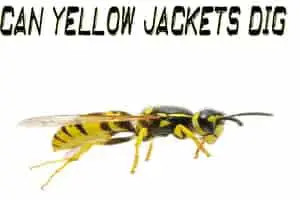
This is a common thought, seeing how some yellow jackets make their nest in holes in the ground
So can Yellow Jackets dig? In a word no. The conditions need to be right yellow jackets that burrow in the ground will normally find soil that is already loose and will begin to push the dirt further to accommodate their needs. Yellow Jackets will use old burrows from moles, voles, gophers, rats, and really anything that burrows to make their underground nest.
So if you think you can throw a clod of dirt over a Yellow Jacket hole and say job well done, think again!
Where Do Yellow Jackets Make Their Nest?
Well, we already know they will burrow holes in the soil, but where else might you find a Yellow Jacket Nest?
Here Are Some Places:
- Under Home Foundation
- Behind Siding
- Under Sheds or Out Buildings
- Attics
- Hollowed Trees
- Eaves
- Soffits
- Leave Piles
This is just a few to name since there are so many places that the Queen Yellow Jacket may choose to make her nest.
Will Yellow Jackets Return To An Old Nest?
No, the queen that created that nest dies at the end of the season, and since the queen has a pheromone that attracts all the other Yellow Jackets to her there won’t be any reason that any yellow jackets would return. The newly fertilized female Yellow Jackets from the previous season will overwinter in a safe warm area and come out as new queens. The new queens will start fresh with a brand new nest.
How Many Yellow Jackets Can A Queen Produce?
This will astonish you or bore you if you already knew the answer. One Queen Yellow Jacket can produce between 10,000 – 20,000 Yellow Jackets in a single season. This is also why they are so aggressive in the fall.
Here Are The Types Of Yellow Jackets:
- Workers
- Foragers
- Protectors
- Drones
The drones (males) and future queens are made in larger cells of the nest called brood cells. After the future queens are born they leave the nest looking for drones to mate with.
When Do Yellow Jackets Mate?
This is a great question. Yellow Jackets mate late in the summer season with drones (male yellow jackets). The fertilized females will overwinter in a safe warm place. When the Queen Yellow Jackets emerge in late spring or early summer they will find a new place to make a nest to lay their eggs for the season. Since females only have to be fertilized once to lay eggs for an entire season because of their ability to store the drone’s sperm from the previous season. The only bad thing for them is that the fertilized queens only live one season.
What Do Yellow Jackets Eat?
Yellow Jackets can be helpful in the way that early in the season they will feed on many insects that cause problems such as beetles, grubs, and flies etc. Yellow Jackets also feed on meat, poultry, and fish at this time. The reason Yellow Jackets feed on these things early in the season is so they can help feed the larvae in the nest, they benefit more from the nutrients of these things.
Later in the season, you will see them around dumpsters and garbage cans, amusement parks, football games and picnics looking for sugars, they will also feed on the nectar of flowers.
Yellow Jackets do help the pollination process but because they are so aggressive to humans and pets they are of no further value.
Can Yellow Jackets Sting More Than Once?
Yes, since yellow jackets have a smooth stinger generally don’t lose it when they attack they can sting and bite. Sometimes they bite first so that they can adjust their bodies for a good sting.
Yellow Jackets are the most vicious wasps, they do have venom that is transferred through their sting. It is important to remember to keep your distance from a foreseeable nest. There are many times you won’t see the ground nests and if you are mowing your yard the vibration of the mower will get them in an uproar. If this happens you will need to run about 70 yards to get off their radar.
Allergic Reactions To Stings
Just know that, even though some people may have a little pain from a sting, there are others that may have an allergic reaction to it. So if the swelling is really bad or you have difficulty breathing, the only fix is to get medical help as quickly as you can. Most emergency rooms and doctors have medication to reverse the effects of the sting in a matter of minutes.
How Do I Get Rid Of Yellow Jackets On My Own?
Do not attempt to get rid of a Yellow Jacket nest if they are alert. The best time to treat is at night since the protectors of the nest will be sleeping at this time.
Things You Will Need:
- Long Sleeve Shirt or Jacket
- Long Pants
- Gloves
- Eye Protection
- Paper Mask
- A Bellows Duster
- Tempo 1%Dust
- CB-80
Ground Nest Approach
Make sure to wear your protective gear at all times during the process. Fill the bellows duster half full of the tempo dust, grab you can of CB-80 and let’s go. You will want to start by unfolding the straw on the CB-80 can and you will want to have both chemicals ready at the same time. Spray the CB-80 into the entry hole of the Yellow Jacket nest for 5 seconds, quickly pull it out and pump the bellows duster with 2-3 puffs in the entry of the Yellow Jacket entry hole as well.
Siding Or Attic Approach:
If you can find during the day the entry point(s) the Yellow Jackets are getting in and out from you will want to just use the dust to treat these areas. The reason is CB-80 should only be used inside your house if you are bombing it for certain bugs. It is a very serious chemical and if you aren’t wearing a respirator inside it can cause serious respiratory issues.
If you feel like the problem can only be solved by using CB-80 inside along with the dust…
Here Is What You Need To Do:
- Turn Off The HVAC
- Make Sure No Fans Are Running
- Wear A Respirator
You will need to be out of the house for 4 hrs. If you have fish or birds this is not even an option for you unless they are vacated for a 24 hour period after spraying.
When you spray, hold the can upright in the air extended from your body, make sure to hit all wall voids that the Yellow Jackets have made their way into. Do not spray into HVAC vents or returns.
Reminder: If you have pets or children you do not want them getting into the dust you just applied, make sure that they are secure and nowhere near the place of application. Tempo Dust can cause mild irritation if it comes in contact with your skin.
Summary:
Yellow Jackets have the ability to dig. Yellow Jackets will always make a new nest every year and new queens will not inhabit an old nest. One queen can produce up to 20,000 Yellow Jackets in one season. Future queens will mate with drones late in the summer season and hold the sperm until next season when they lay their eggs. Yellow Jackets eat protein and sugar for their diet. Yellow Jackets do have the ability to sting more than once. Last but not least you can treat Yellow Jacket nests on your own.

